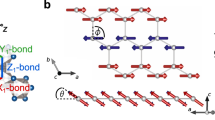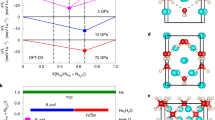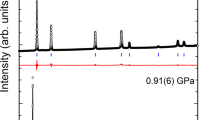Abstract
RHENIUM TRIOXIDE, ReO3, has been thought to be a chemically stable compound in air at room temperature1. The electron diffraction and microscopy measurements reported here reveal, however, that the crystal easily absorbs hydrogen and that this is closely related to its hygroscopic nature. The crystal structure of a new phase, HxReO3 (x<0.1), is estimated from the calculation of the potential field.
This is a preview of subscription content, access via your institution
Access options
Subscribe to this journal
Receive 51 print issues and online access
$199.00 per year
only $3.90 per issue
Buy this article
- Purchase on Springer Link
- Instant access to full article PDF
Prices may be subject to local taxes which are calculated during checkout
Similar content being viewed by others
References
Peacock, R. D. Comprehensive Inorganic Chemistry Vol. 3, 905–978 (Pergamon, Oxford, 1975).
Quinn, R. K. & Neiswander, P. G. Mater. Res. Bull. 5, 329–334 (1970).
Tahara, K. thesis, Univ. Tsukuba (1978).
Kimizuka, N., Akahane, T., Matsumoto, S. & Yukino, K. Inorg. Chem. 15, 3178–3179 (1976).
Wiseman, P. J. & Dickens, P. G. J. Solid St. Chem. 6, 374–377 (1973).
Horiuchi, S., Matsui, Y. & Bando, Y. Jap. J. appl. Phys. 15, 2483–2484 (1976).
Author information
Authors and Affiliations
Rights and permissions
About this article
Cite this article
HORIUCHI, S., KIMIZUKA, N. & YAMAMOTO, A. Absorption of hydrogen in ‘ReO3’. Nature 279, 226–227 (1979). https://doi.org/10.1038/279226a0
Received:
Accepted:
Issue Date:
DOI: https://doi.org/10.1038/279226a0
This article is cited by
Comments
By submitting a comment you agree to abide by our Terms and Community Guidelines. If you find something abusive or that does not comply with our terms or guidelines please flag it as inappropriate.



